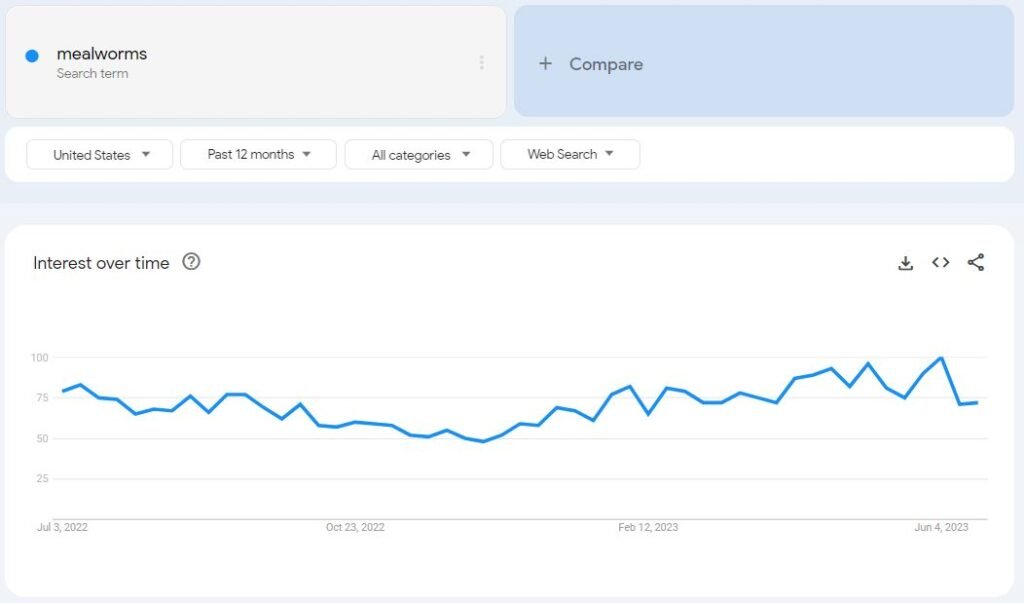Making money from mealworms has become a groundbreaking opportunity that promises not only significant returns but also an environmentally friendly solution towards organic nutrition source.
With various opportunities to capitalize on the growing demand for mealworms, you can tap into a thriving market and turn your passion for these tiny creatures into a profitable venture.
What is a mealworm?
Mealworms are the larvae of darkling beetles (scientifically known as Tenebrio molitor) and have been a part of nature’s tapestry for centuries.

These humble larvae, with their cylindrical bodies and brown exoskeletons, possess a remarkable ability to convert organic waste into valuable nutrients.
While mealworms have long been recognized as a popular food source for reptiles, birds, and other animals, their value has transcended traditional pet care and ventured into the realm of human consumption and sustainable agriculture.
From selling live mealworms and breeding stock to exploring mealworm-based products for human consumption, there are multiple avenues to explore. Let’s delve into the exciting possibilities and discover how you can unlock the potential of making money from mealworms.
Making money from mealworms – top 10 avenues
Mealworm farming can be a lucrative venture with various opportunities to generate income. Here are several ways to make money from mealworm farming:
1. Sale of live mealworm
The sale of live mealworms opens doors to a substantial customer base comprising pet owners and reptile enthusiasts seeking a reliable food source for their beloved companions.
Whether you opt to supply live mealworms in bulk or smaller quantities, there are various channels to explore.
You can establish direct sales to customers, collaborate with pet stores, participate in reptile expos, or leverage the power of online platforms to reach a wider audience.
For instance, consider partnering with local pet shops, showcasing the vitality of your live mealworms and providing pet owners with a convenient and consistent source of nutrition for their cherished animals.
2. Breeding stock
Another avenue to consider is the sale of high-quality breeding stock to fellow mealworm farmers.
As the demand for mealworms continues to rise, there is a growing need for robust and productive adult mealworms to support the expansion of existing colonies.
By offering your healthy and thriving adult mealworms as breeding stock, you not only contribute to the industry’s growth but also provide other farmers with the opportunity to establish or enhance their own colonies.
This collaboration can be helpful in generating a steady stream of income for you.
3. Mealworm products for animal feed
Expanding your horizons beyond live mealworms, you can tap into the market for mealworm products designed specifically for animal feed.

Consider processing your mealworms into valuable mealworm flour or pellets, which can be incorporated into animal feed formulations.
You can establish partnerships with animal feed manufacturers, supplying them with your premium mealworm products or directly reach out to farmers who prioritize superior nutrition for their animals.
4. Mealworms for fishing bait
The world of fishing holds a special place in the hearts of enthusiasts, and mealworms have become a go-to bait for many anglers.
By recognizing this demand, you can venture into packaging and selling live or dried mealworms specifically for fishing bait, casting your net wide and catering to the needs of fishing enthusiasts and bait shops alike.
Partnering with local bait shops or establishing an online presence can be an effective way to reach your target audience.
Consider creating enticing packaging, sharing informative tips on baiting techniques, and engaging with fishing communities to establish your brand as a trusted provider of top-quality mealworms.
5. Mealworm-based products for human consumption
The culinary world is constantly evolving, embracing new and sustainable food sources. Mealworms, with their rich nutritional profile and eco-friendly qualities, have gained recognition as a viable ingredient for human consumption.
This presents an exciting opportunity to explore the creation of mealworm-based products that cater to health-conscious consumers or specialized food stores.
6. Mealworms as fertilizer
Gardening enthusiasts, nurseries, and organic farms share a common quest for natural and sustainable fertilizers.
As a mealworm farmer, you can package and sell this organic treasure as a valuable soil amendment, enriching the growth potential of plants and nurturing the green thumb community.
You can make good money by providing gardening enthusiasts with carefully packaged mealworm frass, highlighting its exceptional nutrient content and the benefits it offers to plants.
Collaborating with local nurseries, showcasing the effectiveness of mealworm frass in plant growth, can help you establish a strong presence in the gardening community.
7. Educational Workshops and Classes
Sharing your expertise and passion for mealworm farming can extend beyond your own farm.
By conducting educational workshops, classes, or seminars, you can empower individuals interested in starting their own mealworm farms while generating income through attendance fees.
8. Value-Added Services
Beyond the core activity of mealworm farming, there are numerous value-added services you can offer to augment your revenue stream.
By leveraging your expertise, you can provide specialized services for which you can charge a fee, catering to individuals seeking additional support in their mealworm farming endeavors.
Consider offering consulting services, where you share your knowledge and experience with aspiring farmers, guiding them through the intricacies of setting up and maintaining a thriving mealworm colony.
You can provide personalized advice, addressing specific challenges or goals, and empowering others to achieve success in their own farming ventures.
Furthermore, you can develop custom breeding programs tailored to the unique needs and preferences of clients. Whether it’s selecting specific traits or optimizing breeding techniques, these programs can help individuals establish colonies that align with their desired outcomes.
In addition, some individuals may require assistance in setting up their own mealworm farm, from infrastructure design to initial colony establishment. By offering colony setup assistance, you provide practical support, ensuring a smooth and successful start for budding farmers.
9. Online content and sponsorships
In the digital age, sharing your mealworm farming journey through online platforms opens up exciting opportunities for monetization.
As you create compelling content and cultivate a dedicated following, you can leverage your online presence to generate income through advertisements, sponsorships, or affiliate marketing.
Imagine starting a blog or launching a YouTube channel where you document your experiences, share educational resources, and provide insights into the fascinating world of mealworm farming. Through engaging and informative content, you captivate an audience of enthusiasts, aspiring farmers, and curious minds.
As your online following grows, you can explore collaborations with relevant brands or companies in the mealworm industry. For instance, a company specializing in mealworm-based products may sponsor your content, providing financial support in exchange for product promotion or brand exposure to your audience.
Additionally, you can monetize your online presence through advertisements displayed on your platforms. Platforms like YouTube offer revenue-sharing programs that reward content creators based on the number of views and engagement their videos receive.
10. Affiliate marketing

Moreover, by becoming an affiliate marketer, you can earn a commission by promoting relevant products or services to your audience. For example, you may partner with a reputable supplier of mealworm farming equipment and recommend their products through affiliate links, generating income for each successful referral.
Growing demand for mealworms in various industries
The demand for mealworms has experienced a remarkable surge in recent years, driven by a confluence of factors.
One of the primary catalysts is the global pursuit of sustainable and environmentally friendly practices.
Mealworms, with their high protein content and comparatively low environmental footprint, have emerged as a viable solution to meet the growing demand for sustainable protein.

With their balanced nutritional profile and ease of cultivation, mealworms offer a natural and nutrient-rich supplement for animals.
The pet industry, in particular, has witnessed a surge in mealworm-based products, catering to the evolving preferences of pet owners seeking wholesome and sustainable options for their beloved companions.
The potential for profit in mealworm farming goes beyond the sale of live mealworms.
Entrepreneurs have ventured into value-added products, such as mealworm flour, protein bars, and even mealworm-based skincare products.
These innovative offerings have captured the attention of health-conscious consumers and eco-conscious individuals seeking alternative and sustainable choices.
How to start mealworm farming
1. Setting up a mealworm farm
The first step is to set up a mealworm farm, ensuring that your infrastructure and equipment are carefully chosen and well-suited for the task at hand. Think of it as constructing a reliable home for your wriggling companions.
To create an ideal environment for your mealworms, you’ll need to consider various factors.
- Design a space that optimizes temperature, humidity, and ventilation control to promote their well-being.
- Invest in sturdy shelving units or containers to accommodate the growing colony, allowing for easy access during feeding, cleaning, and harvesting.
2. Sourcing mealworms for breeding stock
To begin your mealworm farming venture, obtaining high-quality breeding stock is paramount.
These resilient pioneers will lay the foundation for a flourishing colony, so it’s crucial to source them wisely.
Seek reputable suppliers or established mealworm farmers known for their healthy and productive adult mealworms.
When selecting your breeding stock, look for vibrant, active mealworms with plump bodies.
Avoid individuals displaying signs of disease, weakness, or deformities. Remember, the success of your future generations hinges on the strength and vitality of the initial breeders.
3. Creating an optimal breeding environment
To unlock the full potential of your mealworm colony, you must provide them with an optimal breeding environment—a nurturing haven where they can thrive and multiply.
It’s like curating a luxurious spa retreat tailored to their specific needs.
Maintaining a consistent temperature within the optimal range, typically between 25°C to 30°C (77°F to 86°F), fosters the best breeding conditions.
Keep the humidity level around 70% to 80%, ensuring a sufficiently moist environment without excess dampness. Adequate airflow helps prevent moisture buildup and maintains a fresh atmosphere.
4. Understanding the life cycle of mealworms
From tiny eggs to larvae, pupae, and finally emerging as adult darkling beetles, mealworms undergo a metamorphosis that holds the key to their sustainable reproduction.
As you observe and interact with your mealworms, you’ll witness their growth stages unfold.
The eggs will hatch into tiny larvae, which will shed their exoskeletons several times as they grow larger.
These instar stages are crucial milestones, eventually leading to the pupal stage, where significant transformations occur within a protective cocoon. Finally, the darkling beetles emerge, ready to continue the life cycle anew.
By comprehending the intricacies of their life cycle, you can anticipate and adapt to the varying needs of your mealworms at each stage, fostering their development and ensuring a thriving population.
5. Estimating initial investment and start-up costs
Consider the expenses involved in setting up your mealworm farm, including infrastructure, equipment, and any necessary permits or licenses.

Calculate the costs of shelving units, containers, heating or cooling systems, lighting, and other essential components. Factor in initial inventory costs, such as breeding stock, feed, and substrate, to ensure a solid foundation for your colony’s growth.
6. Calculating ongoing expenses
Once your mealworm farm is up and running, it’s important to estimate the ongoing expenses required to nurture your flourishing colony.
Think of it as tending to a thriving garden, where continuous care and maintenance are necessary to sustain its vibrancy.
Take into account the expenses associated with feed, substrate, and maintenance.

Calculate the costs of providing a nutritious diet for your mealworms, whether it’s commercial feed or homemade blends.
Assess the expenditures for substrate materials, such as oats or bran, which serve as a nurturing medium. Additionally, account for regular maintenance tasks, including cleaning, monitoring temperature and humidity levels, and addressing any unforeseen challenges that may arise.
7. Financial projections and return on investment (ROI)
As you navigate the financial landscape of mealworm farming, it is vital to project your financial outcomes and calculate the return on your investment (ROI).
Just as a diligent farmer anticipates the harvest’s yield, you too must envision the fruits of your labor in financial terms.
Prepare financial projections that outline your expected revenue, expenses, and profitability over a specified period. Factor in variables such as market demand, pricing strategies, and potential growth opportunities. Monitor and analyze key performance indicators, adjusting your approach as needed to optimize your ROI.
By continually evaluating your financial progress and adapting your strategies, you can ensure the sustainable growth of your mealworm farming enterprise while reaping the rewards of your dedication and hard work.
Final thoughts on making money from mealworms
Mealworm farming offers a multitude of opportunities to generate significant profits and thrive in a dynamic industry. From selling live mealworms as fishing bait to exploring mealworm-based products for human consumption, the possibilities are abundant. Additionally, offering value-added services, collaborating with research institutions, and leveraging online platforms can further diversify revenue streams and amplify success.

